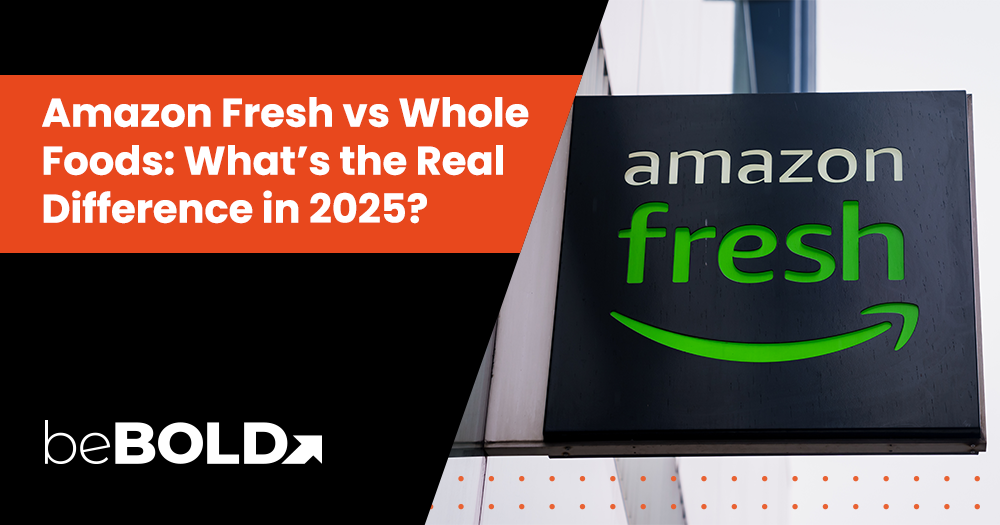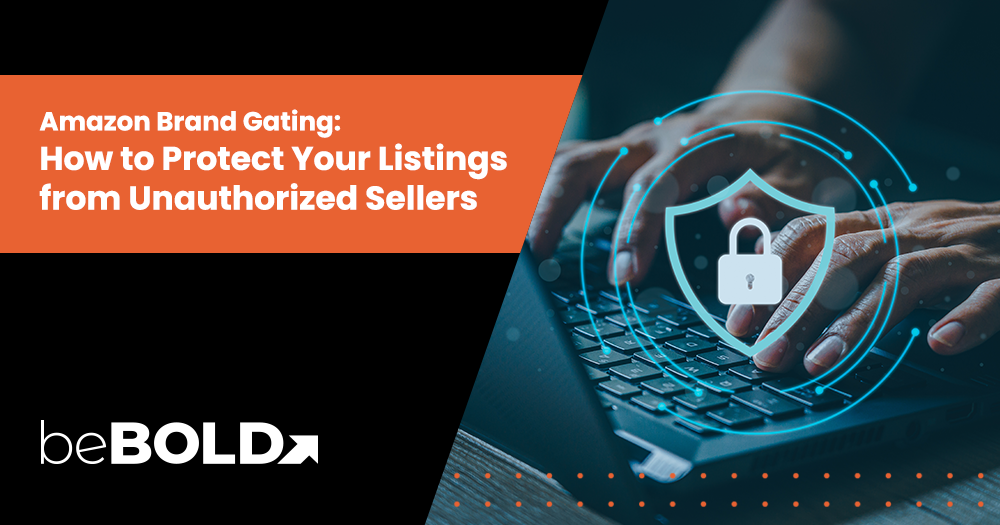Thinking about using Amazon for grocery delivery? If you've ever wondered about the difference between Amazon Fresh and Whole Foods Market, you're not alone. Though both are part of the Amazon grocery ecosystem, they serve different customer needs and have different implications for sellers. Here's what you need to know.
Key Summary
- Amazon Fresh is perfect for mass-market brands targeting convenience and affordability 🛒
- Whole Foods appeals to premium, organic, and sustainability-driven consumers 🌱
- Inventory standards differ greatly—Whole Foods has rigorous vetting; Amazon Fresh is more open 🧾
- Sellers can scale faster with Amazon Fresh but build prestige through Whole Foods 📈
- Both platforms offer unique delivery experiences: warehouse fulfillment vs. store-based fulfillment 🚚
- Choosing the right channel depends on your brand's positioning, values, and operational readiness 🧭
Amazon Fresh vs Whole Foods: Feature Comparison
|
Feature |
Amazon Fresh |
Whole Foods Market |
|
Audience |
Budget-conscious, mainstream consumers |
Health-focused, premium, eco-conscious shoppers |
|
Product Selection |
Mass-market grocery and CPG products |
Organic, curated, non-GMO, premium goods |
|
Delivery |
Fulfilled via Amazon Fresh warehouses |
Fulfilled from Whole Foods physical stores |
|
Prime Access |
Optional, benefits improved with Prime |
Required for delivery and in-store discounts |
|
Seller Fit |
Easier onboarding, wide category access |
Requires vetting, certifications, strict product standards |
While both services fall under the Amazon umbrella, they cater to vastly different shopping preferences and operational models:
Amazon Fresh Overview
- Audience: Amazon Fresh appeals to budget-conscious, convenience-focused shoppers who want quick delivery of everyday items.
- Inventory: Offers a wide range of standard grocery products including popular CPG brands and household staples.
- Delivery: Fulfilled from centralized warehouses designed for speed and scale. Delivery fees may apply for non-Prime members or small orders.
- Prime Access: Available to both Prime and non-Prime members, though Prime users receive more benefits including free delivery above a minimum threshold.
- Seller Fit: Open to a broad range of sellers; ideal for CPG, pantry, and general grocery products.
Whole Foods Market Overview
- Audience: Attracts premium shoppers who prioritize organic, sustainably sourced, and ethically produced goods.
- Inventory: Highly curated selection with strict ingredient and product standards.
- Delivery: Orders are fulfilled from physical store locations using Prime Now infrastructure. Delivery is only available to Amazon Prime members and may include service fees based on cart size and location.
- Prime Access: Delivery and exclusive in-store discounts are only available to Prime members.
- Seller Fit: Requires more rigorous product approval processes, suitable for wellness-focused or premium brands.
What Type of Shopper Are You? See Where You Fit
Choosing between Amazon Fresh and Whole Foods Market depends on your shopping priorities, lifestyle, and brand values. Here's how to determine the best fit:
- Budget-Conscious Shopper: If your goal is to save money while getting everyday essentials, Amazon Fresh is your go-to. With lower prices on staples like milk, snacks, and cleaning products, it's ideal for families, students, and bulk shoppers.
- Health-Conscious or Organic-Focused Consumer: Whole Foods offers rigorously vetted organic and non-GMO items. If ingredient transparency and sustainability are your top priorities, Whole Foods will align more closely with your values, even if it comes at a premium.
- Urban Professional with a Busy Schedule: Need convenience, speed, and household variety? Amazon Fresh offers same-day delivery on a wide range of goods, including personal care and pet supplies, making it a one-stop shop for busy lifestyles.
- Luxury Grocery Shopper: Shopping for gourmet cheeses, grass-fed meats, or fair-trade chocolates? Whole Foods offers a curated, premium grocery experience that caters to discerning palates and promotes ethical consumption.
- Introverted or Remote-Based Consumers: If avoiding crowds and having groceries delivered is essential, both services deliver. Amazon Fresh may be faster, but Whole Foods offers a more exclusive Prime member experience.
- Brand-Loyal Amazon Prime Members: Are you one of the 220 million subscribers to Amazon Prime? If so, you'll enjoy exclusive Whole Foods discounts and access to member-only sales, making Whole Foods a more attractive option despite higher base pricing.
What is Amazon Fresh?
Amazon Fresh is Amazon's mainstream grocery solution. It was designed to compete with traditional supermarkets by offering a convenient, price-sensitive platform for grocery essentials. Unlike Whole Foods, which targets niche premium buyers, Amazon Fresh is optimized for mass accessibility. The service appeals to urban dwellers, families, students, and everyday consumers who want low prices without sacrificing speed or convenience.
Amazon Fresh aims to bridge the gap between in-store grocery shopping and the fast-paced expectations of eCommerce, especially within metropolitan areas. It is particularly beneficial in markets where Amazon has dense distribution infrastructure, allowing for rapid fulfillment.

Inventory & Delivery Logistics
- Wide range of household names (e.g., Kellogg’s, Nestlé, Heinz)
- Products span snacks, dairy, produce, frozen meals, toiletries, and cleaning supplies
- Delivery fulfilled through Amazon's dedicated Fresh warehouses or partner locations
- Offers same-day or next-day delivery windows based on ZIP code
- Frequently includes promotions and bundle offers to drive bulk orders
One key differentiator is that Amazon Fresh supports grocery-specific user interfaces and shopping experiences within the Amazon app, making it intuitive for repeat purchases, reordering, and list saving.
beBOLD Tip: Need clarity on what Amazon expects from food sellers? Check out How to Sell Food on Amazon for a practical breakdown.
What Are the Pros and Cons of Amazon Fresh?
|
Pros |
Cons |
|
Convenient home delivery |
Limited to select metro areas |
|
Competitive pricing |
Delivery fees may apply |
|
Prime member benefits |
Substitution inconsistencies |
|
User-friendly app and tracking |
Freshness may vary |
|
Time-saving features for busy households |
Fewer specialty or local options |
Pros:
- Convenient home delivery reduces the need for in-store visits
- Competitive pricing, especially on Amazon-brand groceries
- Integrated with Amazon Prime benefits for eligible members
- Reliable delivery tracking and user-friendly app experience
- Time-saving features like reordering, saved lists, and personalized suggestions
- Growing selection of fresh produce and perishable goods
- Ideal for time-starved households and professionals looking for efficiency
Cons:
- Availability varies by region—limited to certain metropolitan areas
- Substitutions for out-of-stock items can be inconsistent
- Delivery fees may apply if minimum order thresholds aren’t met
- Perishables may not always meet in-store freshness standards
- Limited ability to inspect products before purchase compared to physical stores
- May lack local or specialty product availability compared to traditional grocers
- Delivery windows may be less flexible during peak demand periods
What is Whole Foods Market (via Amazon)?
Whole Foods is Amazon’s premium grocery arm, emphasizing organic, non-GMO, and sustainably sourced products. It upholds strict standards for product inclusion. Whole Foods has long positioned itself as a lifestyle-oriented brand that supports health-conscious and environmentally aware consumers. Every product on its shelves must meet quality standards that exclude hydrogenated fats, high-fructose corn syrup, and over 100 artificial ingredients.
Whole Foods also places a strong focus on local sourcing, organic farming, and animal welfare, which appeals to a specific high-value consumer base that’s willing to pay a premium for these assurances. For sellers, this creates a brand halo effect — being accepted by Whole Foods can immediately elevate perceived value.

Inventory & Delivery Logistics
- Product assortment is tightly curated with a focus on organic, non-GMO, and ethically sourced items.
- Inventory includes premium staples, artisanal products, vegan/plant-based options, and wellness-focused SKUs
- Delivery is fulfilled directly from local Whole Foods Market locations using Amazon’s Prime Now infrastructure.
- Prime members can access 2-hour delivery windows in many metro areas through the Amazon app or website.
- Loyalty benefits include 10% off select sale items and weekly Prime-exclusive deals.
What Are the Pros and Cons of Whole Foods Market?
|
Pros |
Cons |
|
🌿 Organic and non-GMO product selection |
💸 Higher price points |
|
✅ Ethical sourcing and strict ingredient standards |
🔒 Prime membership required for delivery |
|
🛍️Exclusive Prime discounts and loyalty perks |
📍 Limited availability based on location |
|
🍷 Curated shopping for premium buyers |
🧂 Narrower selection and fewer budget options |
Pros:
- High-quality organic and non-GMO product selection
- Strict ingredient standards appeal to health-conscious shoppers
- Environmentally and ethically focused sourcing
- Loyalty perks for Prime members, including exclusive discounts
- Reliable fulfillment for metro-area shoppers via local stores
- Curated shopping experience for premium grocery buyers
Cons:
- Higher price points may not suit all budgets
- Limited to Prime members for delivery access
- Inventory is narrower due to strict quality standards
- Availability varies based on proximity to a Whole Foods store
- May lack traditional or budget-brand grocery options
Which Platform is Better for Sellers?

For brands looking to break into Amazon's grocery ecosystem, choosing between Amazon Fresh and Whole Foods involves balancing visibility, accessibility, and alignment with brand values. While both platforms offer incredible exposure, the right fit depends on your product type, brand goals, and operational readiness.
Selling via Amazon Fresh

Amazon Fresh offers a more flexible and accessible route for most sellers:
- Easier Onboarding: Sellers can list on Amazon Seller Central with fewer category restrictions, streamlining the process.
- Lower Barrier to Entry: Compliance and certification requirements are lighter, especially for conventional CPG products.
- High Volume Potential: Appeals to a broad demographic, particularly value-driven shoppers, resulting in increased order volume potential.
- Promotional Opportunities: Leverage tools like coupons, "Subscribe & Save," and Amazon PPC to accelerate growth.
- Retail Infrastructure: Sellers benefit from Amazon’s fulfillment network and visibility within search for everyday essentials.
Selling via Whole Foods

Whole Foods is a curated, premium channel with elevated standards:
- Strict Product Standards: Acceptance requires organic certifications, non-GMO credentials, and adherence to ingredient guidelines.
- High Brand Equity: Being accepted enhances your brand’s perceived quality, which can lead to expanded offline retail opportunities.
- Limited but Premium Audience: Access to Prime-exclusive customers who prioritize values over cost.
- Category Vetting Process: Must align with Whole Foods’ product ethos, often involving manual review or regional approval.
- Operational Complexity: May require specific labeling, packaging, and distribution readiness.
Maximize Your Seller Growth Across Amazon Fresh and Whole Foods
With Amazon groceries projected to reach $26.7 billion in revenue by 2025, with grocery being a major growth vertical, targeting both platforms will only help you increase reach and drive sales. For brands with multi-tier product lines or diversified grocery offerings, using both Amazon Fresh and Whole Foods Market strategically can unlock broad market exposure and build long-term brand value.
- Segment Your Product Line: List your mass-appeal or conventional products on Amazon Fresh to capture high-volume, price-sensitive shoppers. Simultaneously, position your premium, organic, or niche SKUs to align with Whole Foods' values-driven consumers.
- Build Brand Awareness on Fresh, Elevate with Whole Foods: Leverage Amazon Fresh to gain visibility and momentum quickly, then utilize Whole Foods placement as a trust builder that signals quality and integrity.
- Test and Iterate: Use Amazon Fresh’s faster entry and lower risk to experiment with packaging, bundling, or promotional strategies before rolling them out on Whole Foods.
- Optimize Logistics: Fulfill Amazon Fresh orders through Amazon's fulfillment centers while leveraging Whole Foods' physical store infrastructure for hyper-local delivery, ensuring speed and customer satisfaction across all audiences.
- Cross-Sell Through Marketing: Use your Amazon brand store or A+ Content to highlight your availability across both channels. Example: "Find our classic line on Amazon Fresh and our premium organic range at Whole Foods."
With a thoughtful omnichannel strategy, sellers can gain reach, brand equity, and valuable customer insights across Amazon’s diverse grocery platforms.
Ready to Win in Amazon Grocery? Here's Your Next Step
Both Amazon Fresh and Whole Foods serve unique buyer segments and offer different routes for sellers. Amazon Fresh provides scalability, speed, and accessibility for brands looking to reach the everyday consumer with household essentials. On the other hand, Whole Foods offers prestige, niche targeting, and the opportunity to connect with values-driven, high-intent shoppers who prioritize ingredient quality and brand mission.
For consumers, the choice often comes down to price sensitivity versus product ethics and exclusivity. For brands, it's about understanding where your product fits best and how to leverage each platform’s advantages to maximize reach and conversion.
If you’re unsure where your product fits — or if you want to pursue both — our team can help you position, launch, and grow your presence across Amazon's grocery ecosystem. Schedule a call with us today!
Frequently Asked Questions (FAQs)
Is Amazon Fresh the Same as Whole Foods?
No. While both services are owned by Amazon, they serve different purposes. Amazon Fresh is a conventional grocery delivery service targeting everyday consumers, whereas Whole Foods is a premium, organic-first grocery chain with stricter product standards and an upscale positioning.
How Does Amazon Fresh Differ from Whole Foods?
Amazon Fresh focuses on affordability and selection, offering a wide range of household staples, snacks, and consumer packaged goods (CPG) products through warehouse fulfillment. Whole Foods, on the other hand, prioritizes organic, non-GMO, and ethically sourced products, fulfilling orders from its physical store locations.
Is Whole Foods an Amazon Fresh Store?
No. Whole Foods and Amazon Fresh are two distinct entities under the Amazon umbrella. They have separate inventory systems, pricing models, and customer audiences.
Is Amazon Prime Needed for Whole Foods?
Yes. Only Amazon Prime members can access Whole Foods delivery and enjoy exclusive in-store discounts and weekly deals.
Which is Cheaper: Amazon Fresh or Whole Foods?
Amazon Fresh is generally more affordable than Whole Foods. It focuses on conventional, budget-friendly groceries and offers lower prices on everyday staples, whereas Whole Foods prioritizes premium, organic selections with higher price points.
Which Service is Better for Everyday Groceries?
Amazon Fresh is better suited for everyday grocery shopping thanks to its broader product selection, conventional brands, and lower pricing. Whole Foods is ideal for shoppers focused on premium, organic, and specialty foods.
Do Both Amazon Fresh and Whole Foods Offer Same-Day Delivery?
Yes. Both services offer same-day delivery in eligible areas. Amazon Fresh fulfills from warehouses, while Whole Foods delivers from store locations. Availability may vary depending on your ZIP code.
Can I Return Items from Amazon Fresh or Whole Foods?
Yes. Both Amazon Fresh and Whole Foods allow returns for eligible items. Most returns can be initiated via the Amazon app or website, though policies may differ by product type.
Does Amazon Fresh Sell Organic or High-Quality Food Like Whole Foods?
Amazon Fresh carries some organic and high-quality products, but it does not match Whole Foods’ curated selection and strict ingredient standards. If organic sourcing is a priority, Whole Foods is the better choice.
Do Amazon Fresh and Whole Foods Ship Nationally?
No. Both services are limited by geographic availability. Amazon Fresh is available in select metropolitan areas, and Whole Foods delivery is contingent on store locations nearby.
Can I Shop Both Services at the same time, with the same cart?
Not exactly. While both services are accessed via the Amazon platform, they require separate carts and checkout processes due to differences in inventory and fulfillment.









Comments